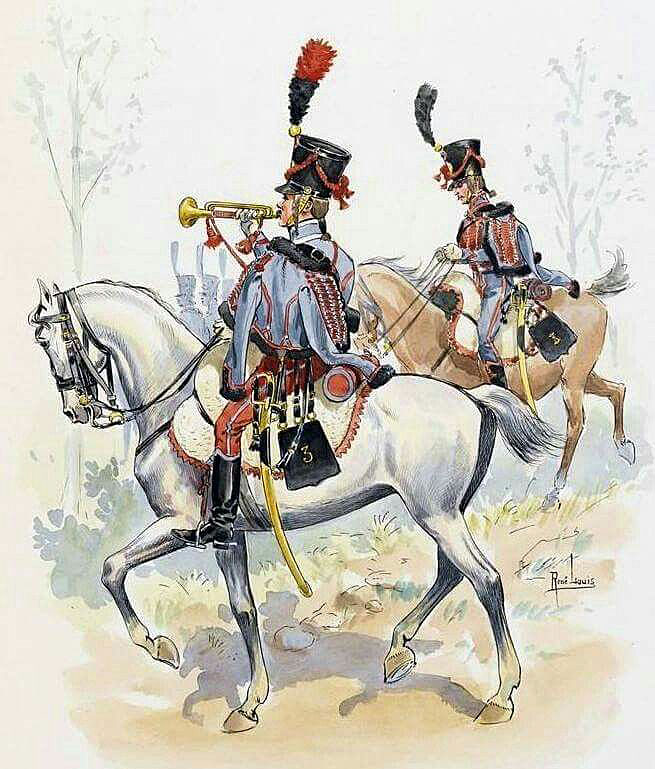
French 3rd Hussars: Battle of Venta del Pozo and Villodrigo on 23rd October 1812 in the Peninsular War
French Gensdarmes at the Battle of Venta del Pozo and Villodrigo on 23rd October 1812 in the Peninsular War
The Battle of Venta del Pozo, also known as the Battle of Villodrigo by the French and Spanish, was a rear-guard action fought as part of the Peninsular War on 23 October 1812 between an Anglo-German force led by Major-General Stapleton Cotton against French cavalry under Major-Generals Jean-Baptiste Curto and Pierre François Xavier Boyer. The result was a French victory.
Joseph Souham’s Army of Portugal forced Wellington to abandon the Siege of Burgos. After a pursuit which included the Battle of Venta del Pozo, he pressed the Anglo-Portuguese back to Salamanca : one of the most desperate cavalry fights took place at Venta Del Pozo.
Wellington, moving his principal force towards a line in the rear, ordered the brigades of Anson and Halkett to remain in front until they should be driven in by the enemy. Halkett placed his light infantry brigade (1st and 2nd KGL) behind a brook, on whose bushy banks a part of his battalions were concealed. The cavalry was in front.
He planned to ambush the French advanced guard. Anson’s cavalry would file across the bridge and presumably the French would follow. After some French squadrons crossed, Ramsay’s six cannons would open fire and Bock’s KGL heavy dragoons (1st and 2nd) would charge them.
The plan miscarried when Anson’s brigade turned the wrong direction after it crossed the span. The light dragoons stopped right in the way, blocking both Ramsay’s guns and Bock’s intended charge zone : by some mistake the heavy brigade had not received orders to charge until the French had crossed the bridge.
The two German battalions in ambuscade now threw in a heavy fire, and were ordered to draw back. After a few minutes, Boyer’s dragoons, which had crossed the stream bed to one flank, swarmed into the melee. The British cavalry retreated in considerable disorder.
The French pursuit soon ran into Halkett’s two battalions, formed in square and the KGL infantry held firm. The French subsequently charged the two battalions in succession, but they managed to hold off the French horsemen and escape intact. The British troops moved and reached the position of the army at Torquemada.
A noted engagement occurred at Venta del Pozo during the British retreat from Burgos late in 1812, in which pursuing French cavalry were engaged by Gen von Bock’s `heavy Germans’ – the heavy dragoon brigade of the King’s German Legion – and Gen Anson’s light brigade, the latter tired from the day’s earlier exertions. It was supposedly the most furious cavalry melée of the Peninsular War, and ended with the retreat of the British when a fresh brigade of French dragoons assailed Anson’s flank; yet the actual clash was evidently momentary. Carl von Hodenberg of the 1st KGL Dragoons, who was present, wrote that:
Our two squadrons on the right. met [the French] with such vigour that we were in an instant completely mixed – friend and foe were hardly to be distinguished. The contest, man to man, lasted perhaps a long minute, during which the ground was strewed [sic] with French, and our own loss was severe in the extreme. The two squadrons of the 2nd Dragoons did not come up quite so firm and compact as ours, so that their first shock did not do so much execution.
The two German heavy regiments suffered 96 casualties, including 11 killed and 42 missing – almost a quarter of their strength.
With enemy forces concentrating in their rear, Wellington’s army now began the long march back to Portugal and safety. They were followed by a French force of over 40,000, who caught up with the British rearguard on 23 October 1812 at a place called Venta del Pozo. Driving in the British cavalry screen, the cavalry of the French advance guard were ambushed by the rifle fire of the 2nd Light Battalion KGL and forced to retire.
They came on again, and the 2nd Light fell back to the positions of the 1st Light Battalion, both battalions forming square to receive cavalry. In this formation they conducted a fighting withdrawal over several miles, supported by the Legion’s 1st and 2nd Dragoons and tile 1st Hussars. The punishing musketry of the Light battalions inflicted heavy casualties on the French cavalry, which again included tile Lanciers de Berg. This model rearguard action was witnessed by Wellington, who sent his thanks and a double rum ration to the German light infantrymen. (Both battalions were later granted the battle honour of ‘Venta del Pozo’, which was still being worn on the cap of the 10th Hanoverian Jager Battalion in 1914, alongside the honours ‘Peninsula’ and ‘Waterloo’
The two battalions of King’s German Legion infantry covered the retreat of their cavalry with great coolness.